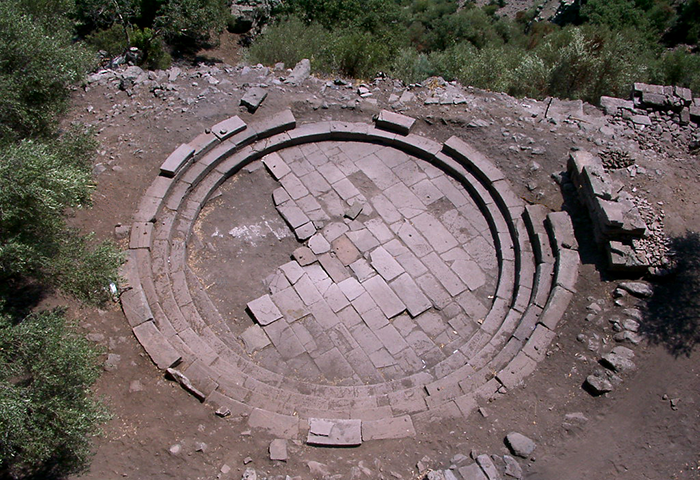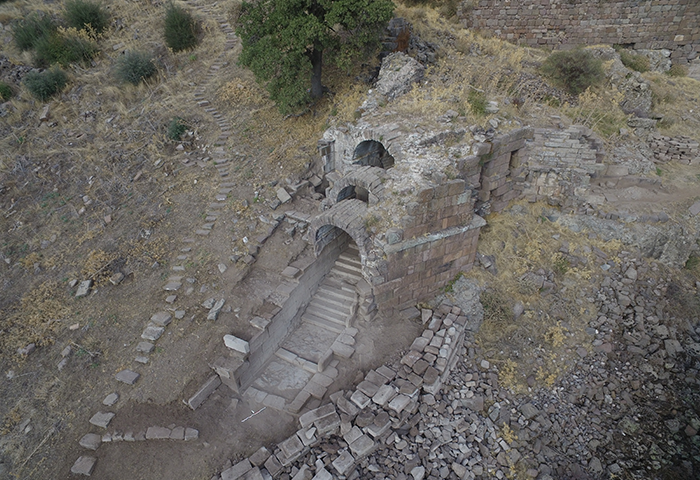

Bouleuterion – Council House
The first data on Bouleuterion has been obtained by the Pergamon excavation team’s research in 1886. An inscribed architrave block found near the Bouleuterion shows that a building was dedicated to Zeus Bollaios, Hestia Bollaia and the demos (the community of citizens) by Antiphanes son of Apollonidas. There is no doubt that this inscribed block was on the façade of Bouleuterion before it was destroyed. […]

Sanctuary of Athena
The sanctuary oriented on the northwest-southeast axis, is located on the western corner of the acropolis surrounded by Archaic Period wall. The sanctuary shows similar features with the Sanctuary of Athena in Pergamon in terms of its position and planning on the terrace that rises at the east of the theater. During the excavation started in 2017, findings with a wide range of dates from the 7th-6th centuries BCE to the Late Byzantine Period were found. […]

Agora
Widely defined incompletely as the “marketplace”, Agora, with a more accurate and comprehensive definition, means the place where communities meet. Agora of Aigai is located on the east of the terrace that the Upper Agora is located, the northeastern slope of the hill where the city is founded. The terrace in question is north-south oriented with its monumental structure. […]

Macellum: The Fish-Meat Market
The area at the same elevation with the ground floor of the Agora Building, on the east of the building, was formed as a terrace or a small square. Another structure in this small square is in a very close relationship with the building. The structure must have served as a fish and/or meat market which the Hellens called “Makellon” and the Romans “Macellum”. The structure covers 8,56 m area has four steps made of worked stone slabs. […]

Theater
The Theater of Aigai was built on the sloped ground at the west of the terrace of the Sanctuary of Athena. The placement of the Sanctuary of Athena and the Theater show similarities with the Sanctuary of Athena and the Theater of Pergamon. While Vitruvius defines an ideal location for a theater, he states that it should be sheltered from direct wind and sun. The Theater of Aigai is located in an area completely protected from northern winds with this placement. […]

Insula 1 Neighbourhood
The first structure that every visitor who follows the ancient road from the Necropolis (cemetery area) to the city is the city gate named Gate of Agora Street. We see a small quarter that welcomes you with its coolness at a point facing the north wind, after the door. The area, called the Industrial Quarter, had been hosted many masters and merchants until about 1800 years ago. The industrial quarter, with a width of approximately 950 m2, had considerable size for that period. […]

Gymnasion and Bath
There is a plain area where the Theater, Temple of Demeter and Kore, Gymnasion and the Gymnasion Bath is located on the southwestern part of the city. This area was created with the help of a very long terrace wall. Important public buildings on this terrace are protected from northern winds. One of these, the Gymnasion, is located in the southeast of the Theater. It is surrounded by two stoai from the east and south directions. […]

Stadion
A city gate supported by two round towers is located on the southern walls of the city. The gate provides access from the south of the city, especially from the direction of Kyme, differs from other city gates with its elaborate architecture and size. A stone-paved road leading to the public buildings (Theater, Gymnasion, Gymnasion Bath, etc.) on the western terrace of the city is approximately 432 m long. At the 220 m of the road, a wide area located at the left draws attention. […]

Necropoleis
Aigai’s necropoleis are located in three areas. The largest necropolis is situated on the northeastern part of Gün Mountain and on the northern slopes of the valley where the ancient road between Gryneion and Magnesia passes. Other necropoleis are on the west and south of the city. Necropoleis were shaped around the ancient roads leading to the city. The Eastern Necropolis is on the road leading to the city from the east, possibly from the Temnos. […]

Temple of Apollo Chresterios
Archaeological, epigraphic and numismatic data show that one of the most important gods in the city was Apollo. Sanctuary of Apollo Chresterios is one of the most important sanctuaries of the city. It is located on the shore of Kocaçay (ancient Pythikos) near the stone paved road between Aigai and Magnesia ad Sipylos. The Stone paved road between the northern gate of the city and the sanctuary, located on the outer wall of the city is approximately 3,5 km long. […]

Temple of Demeter-Kore
A temple is located at the west of the Theater stage building on the north end of the southwestern terrace of the city. The area is bordered by a steep slope to the north of the bedrock and to the west. It was identified as the Temple of Demeter and Kore based on an inscription found in the area in 1886, by German researchers. The expression “Demeter, Kore and other gods worshiped in the temple” in the inscription dated to the 2nd century BCE, […]

Gate of Agora Street
One of the Aigai’s necropolises is located on the northeastern slopes of the hill where the ancient city is. One of the roads that run through the necropolis reaches to the city wall. There are two gates on the northern and The earliest tombs are contemporary with the foundation of the city and dated to the end of the 8th century BCE. […]

Gate of Demirkapı
Gate of Demirkapı, which is also mentioned by its name in studies carried out by former researchers, was the only entry point to the upper city until 2004 when the excavation was started. Gate of Demirkapı, which has been serving since the Archaic Period, was probably blocked and canceled in the Roman Period. The cancelation of the gate with lintel and architrave blocks removed from various obsolete structures, must have been associated with construction of […]

Defence Systems
It is known that the settlement areas expanded on an enormous scale with the intense development programs carried out in the city during the Hellenistic Period. On the other hand, the political uncertainties experienced during the Diadokhoi Period and the conflicts it brought along created an extremely unsafe environment for the region. For these reasons, defense lines were built on a single route on the northern slope of the city […]

Cisterns and Drainage System
Aigai relied on rainwater throughout its life. The corrosive effect of rainwater on the foundations of buildings has been minimized ingeniously by drainage channels. The drainage system lied under the stone-paved road system directed water to cisterns which are hundreds in number, open basins for livestock and bathhouses’ depots. Waterrelated infrastructures were a vital necessity for Aigai. There are several options of supplying water to a densely populated ancient city […]

Ancient Roads
Studies for the identification and excavation of the ancient roads in and around the city has been continued uninterruptedly since the beginning of the excavation. By uncovering the ancient roads inside and around the city, the city’s plan and city’s relationship with its surroundings can be understood better. Also, visitors can walk along the original, two thousand years old roads and have a more comfortable visitation […]

Byzantine Structures
After the Aigai was abandoned in the third quarter of the 3rd century CE, settling started again in the late 12th century CE. In the council lists containing medieval historical data, the name Aigai is mentioned as one of the auxiliary bishops of Ephesus, affiliated to the Asia Diocese. Name of the city is also in councils of 451 / Khalkedon and 787 / II. Nikaia. However, it is not seen in the bishop lists after 1230 […]
